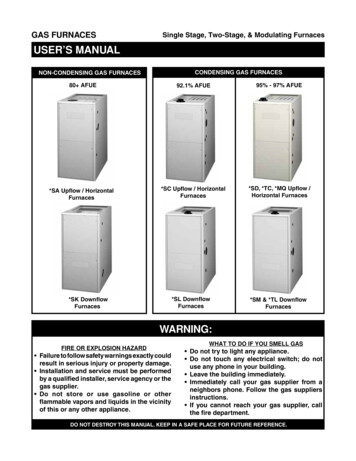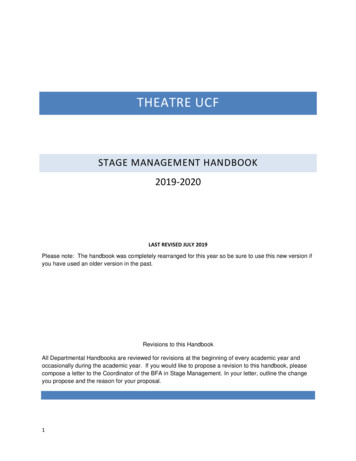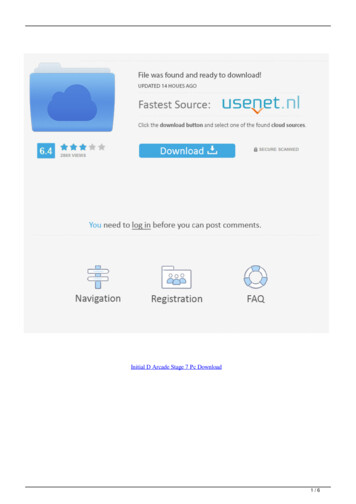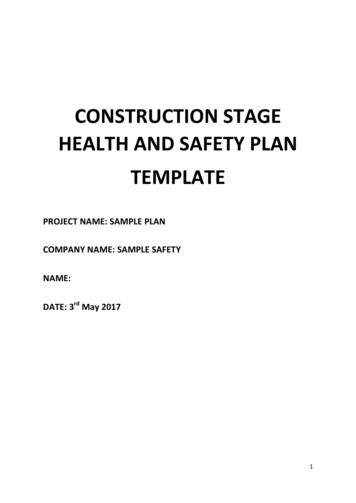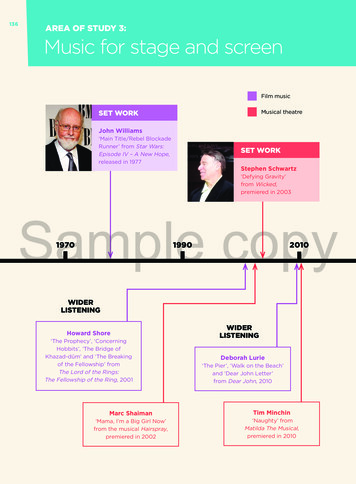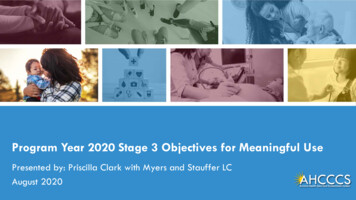
Transcription
Program Year 2020 Stage 3 Objectives for Meaningful UsePresented by: Priscilla Clark with Myers and Stauffer LCAugust 2020
Stage 3 Learning Objectives Understand the Stage 3 requirements for the MedicaidPromoting Interoperability (PI) program. Understand the differences between Program Year (PY)2019 and PY 2020. Learn about PY 2020 Stage 3 documentationrequirements.2
Meaningful Use: HITECH Act Description The Recovery Act specifies the following 3 components of meaningful use (MU):Meaningful MannerUse of certified electronic health record technology(CEHRT) in meaningful manner.Electronic ExchangeUse of CEHRT for electronic exchange of healthinformation to improve quality of health care.Clinical QualityMeasuresUse of CEHRT to submit clinical quality measures (eCQM)and other such measures selected by the secretary.3
Meaningful Use Health Outcome Priorities Improve quality, safety, efficiency, and reduce healthdisparities Engage patients and families in their health care Improve care coordination Improve population and public health Ensure adequate privacy and security protections for personalhealth information4
Overview of Requirements5
Meaningful Use (MU) Requirements* All Eligible Professionals (EPs) are required to attest to Stage 3 of MU for PY 2020.All EPs must have 2015 Edition CEHRT implemented.8 objectives and their related measures must be met.oo 5 objectives are percentage-based measures3 objectives are yes/no measuresIf exclusions are selected, must meet exclusion criteria.Must report on minimum required number and type of eCQMs.Must maintain at least 80% of all unique patients’ data in CEHRT.Must perform at least 50% of all encounters at locations with CEHRT.*In addition to meeting the MU requirements listed above, the EP must meet all eligibility requirements of the program. To learnabout those eligibility requirements use the following link: Documentation Retention**.**To access the webinar click on the link above, then click the drop down arrow labeled “Educational Resources”. An updatedDocumentation Retention webinar for PY 2020 is planned for November 5, 2020.6
Program Year 2020 Meaningful Use ReportingPeriod Length PI (EHR) Reporting Period:oo The PI (EHR) reporting period is 90 days for all EPs.The PI (EHR) reporting period must be within calendar year (CY) 2020.eCQM Reporting Period:ooThe eCQM reporting period is 90 days for all EPs.The eCQM reporting period must be within CY 2020.7
2015 Edition CEHRT EPs must use 2015 Edition CEHRT for PY 2020.The 2015 Edition CEHRT did not have to be implemented on January 1, 2020.ooThe CEHRT must be implemented by the first day of the PI (EHR) reporting period.The CEHRT must be certified by ONC as a 2015 Edition product by the last day of thePI (EHR) reporting period. For example, the 2015 Edition may have been implemented by the practicebefore the start of the PI (EHR) reporting period even though the product isstill pending ONC certification. However, the certification must be approvedby ONC by the last day of the PI (EHR) reporting period.See the ONC website to learn when various CEHRT products were certified.8
Documentation for 2015 Edition CEHRT EPs must use 2015 Edition CEHRT for PY 2020. CEHRT documentation should include:o Date the 2015 Edition CEHRT was implemented;o Edition number; ando Practice name. Examples: CEHRT contract, vendor letter, etc.9
General Requirements Must maintain at least 80% of all unique patients’ data at locations withCEHRT in the CEHRT. Must perform at least 50% of all encounters at locations with CEHRT.oEPs who practice in multiple locations must have 50% or more of their patientencounters during the PI (EHR) reporting period at a location(s) equipped withCEHRT.10
Documentation for General Requirements Submit a detailed encounter listing for the reported 90-day PI (EHR) reportingperiod in Excel containing the following fields:oooooPatient name or unique identifierDate of serviceDate of birthLocation nameIdentify which patients do not have data maintained in the CEHRT if they wereseen at a location that has CEHRT.11
Definitions of Documentation Terms EPs are required to upload documentation for each measure. The followingslides describe the documentation required for each measure.oStandard Documentation: There are two standard types of documentation: ooYes/no standard documentationPercentage-based standard documentationAdditional Documentation: The EP must submit standard documentation and theadditional documentation listed.Alternate Documentation: The EP has the option to submit alternatedocumentation in lieu of the standard documentation.12
Stage 3 Objectives#ObjectiveType of MeasureDocumentationResources1Protect Patient Health InformationYes/NoSee SRA webinarSRA Webinar**2Electronic PrescribingPercentage-BasedPercentage-Based Standard*Electronic Prescribing Webinar**3Clinical Decision SupportYes/NoYes/No StandardClinical Decision Support Webinar**4Computerized Provider Order EntryPercentage-BasedPercentage-Based StandardComputerize Provider Order EntryWebinar**5Patient Electronic AccessPercentage-BasedAdditional Documents willbe requested*Patient Electronic Access Webinar**6Coordination of CarePercentage-BasedPercentage-Based Standard*Coordination of Care Webinar**7Health Information ExchangePercentage-BasedPercentage-Based Standard*Health Information ExchangeWebinar**8Public Health ReportingYes/NoYes/No Standard*Public Health Reporting Webinar****Additional documentation may be needed if exclusion is claimed.**For more detailed information, access the webinar or FAQ by clicking on the appropriate link above, then click the drop down arrow labeled “Educational Resources”.***An updated Public Health Reporting webinar for PY 2020 is planned for September 17, 2020.13
Standard Documentation:Percentage-Based Measures Unless otherwise specified, submit the CEHRT dashboard for all percentagebased measures.CEHRT dashboard should:oooo Reflect the correct PI (EHR) reporting period;Include the provider name;Reflect all percentage-based measures; andMatch the attestation.If attesting to an exclusion for a measure, the CEHRT dashboard may beutilized to support meeting the exclusion criteria for certain measures.If the exclusion is not supported by the CEHRT dashboard, additionaldocumentation is required.14
Standard Documentation:Yes/No Measures Documentation to support yes/no measures must be submitted.The CEHRT dashboard alone cannot be used to support these measures.Documentation could include:o Screen shots from the CEHRT or vendor letters to support the applicablefunctionalities were enabled or the actions required were performed.o Documentation submitted should: Include the provider and/or practice name, as applicable;Reflect results for the measure;Be clearly legible; andReflect the date the requirement was met (see next slide).15
Standard Documentation:Yes/No Measures Continued The appropriate date* of supporting documentation varies depending on themeasure.o Security Risk Analysis (SRA) (Objective 1): The SRA must be completed on orafter the end of the PI (EHR) reporting period and no later than December 31,2020.o Clinical Decision Support Rule (CDS) and Drug-Drug and Drug-Allergy InteractionChecks: Reflect a date the requirement was met during the PI (EHR) reportingperiod.o Public Health Measures: Reflect a date within 60 days of the start of the PI (EHR)reporting period. Providers that completed registration in a previous year meet active engagementoption 1.*Documentation should reflect the date the requirements were met. For example, if submitting a screen shot, capture the date the screenshot wastaken (i.e. the date in the toolbar).16
Stage 3 Compliance Summary#Objective1ComplianceEP State ExceptionsExclusionsMeasureProtect Patient Health InformationAll EPsNo ExceptionsNo Exclusions Available2Electronic PrescribingAll EPsNo ExceptionsExclusion AvailableM1, M23Clinical Decision SupportAll EPsNo ExceptionsExclusion AvailableM24Computerized Provider Order EntryAll EPsNo ExceptionsExclusion AvailableM1, M2, M35Patient Electronic AccessAll EPsNo ExceptionsExclusion AvailableM1, M26Coordination of CareAll EPsNo ExceptionsExclusion AvailableM1, M27Health Information ExchangeAll EPsNo ExceptionsExclusion AvailableM1, M2, M38Registry Reporting (PHR/CDR)N/AArizona Department of Health Services - State Public Health AgencyImmunization Registry Reporting*All EPsNo ExceptionsExclusion AvailableM1Syndromic Surveillance ReportingAll EPsExceptions for Arizona EPsExclusion AvailableM2Electronic Case ReportingAll EPsExceptions for Arizona EPsExclusion AvailableM3Public Health Registry Reporting**All EPsException for Arizona EPs 100 cancer casesException for Arizona EPs not in Specialty List (7)Exclusion AvailableM4Clinical Data Registry ReportingAll EPsNo Exceptions (refer to CMS QCDR on slide 70)Exclusion AvailableM5*Immunization Registry Reporting requires Bi-directionality in order to meet the measure.**Cancer Registry accepted for EP specialties: Dermatologists, Gastroenterologists, Hematologists, Medical Oncologists, Radiation Oncologists, Surgeons and Urologists.17
Stage 3 Exclusions*#Objective1Exclusion 1Exclusion 2Exclusion 3Exclusion 4Exclusion 5Protect Patient HealthInformationNoneNoneNoneNoneNone2Electronic Prescribing 100 PermissiblePrescriptions 10 milesNo PharmaciesNoneNoneNone3Clinical Decision SupportNone 100 MedicationsNoneNoneNone4Computerized ProviderOrder Entry 100 Medication 100 Laboratory 100Diagnostic ImagingNoneNone5Patient Electronic AccessNo Office VisitsBroadbandNoneNoneNone6Coordination of CareNo Office VisitsBroadbandNoneNoneNone7Health InformationExchange 100 Transfer/ReferBroadbandNoneNoneNone8Registry Reportingo Public Health Registryo Clinical Data RegistryDo not administerRegistry not acceptingReadiness not declaredData not collectedRegistry not acceptingReadiness not declaredDo not diagnose/treatRegistry not acceptingReadiness not declaredDo not diagnose/treatRegistry not acceptingReadiness not declaredDo not diagnose/treatRegistry not acceptingReadiness not declared*Additional documentation needed for exclusions.18
Stage 3 eCQM Requirements EPs must attest to 6 out of 47 available eCQMs.ooo 6 outcome measures27 high priority measures14 remaining measuresPriority Level 1: If relevant, at least one eCQM should be an outcome measure.oPriority Level 2: If no outcome measure is relevant, at least one eCQM should be a highpriority measure. Priority Level 3: If no outcome or high priority measures are relevant, report on relevantmeasures if possible.Clinical Quality Measures Webinar**To access the webinar click on the link above, then click the drop down arrow labeled “Educational Resources”. An updated eCQM webinar for PY2020 is planned for October 8, 2020.19
Documentation for eCQMs Run an eCQM report from the CEHRT for the appropriate reporting period.Prove the eCQM data was calculated by a 2015 Edition CEHRT.o The report must show the CEHRT name; oro Screen shots demonstrating how the report was pulled from the CEHRT.The report should include the following:o The required number and type of eCQMs.o The numerator and denominator for each eCQM.o The most recent eCQM version the CEHRT has available.o The proper reporting period.20
Changes from PY 2019 to 2020Objective or eCQM20192020Objective 5,Measure 1 - PatientElectronic AccessAPI can be enabled before, during orafter the PI (EHR) reporting period aslong as it was enabled by 12/31/2019.API must be enabled within 48 hours of theinformation being available to the EP foreach patient so that timely access to theirhealth information via the API is an optionfor the patient.eCQM ReportingPeriodThe eCQM reporting period in PY 2019 is365 days for all returning MU EPs.The eCQM reporting period in PY 2020 is 90days for all EPs.eCQMsEPs may select 6 eCQMs out of 50available eCQMs.EPs may select 6 eCQMs out of 47 availableeCQMs.There were no other changes between PY 2019 and PY 2020.21
MU Objective Details22
Objective 1 – Protect Patient HealthInformation23
Protect Patient Health Information Objective: Protect electronic protected health information (ePHI) created ormaintained by the CEHRT through the implementation of appropriatetechnical, administrative, and physical safeguards.Measure: Conduct or review a security risk analysis in accordance with therequirements under 45 CFR 164.308(a)(1), including addressing the security(including encryption) of data created or maintained by CEHRT in accordancewith requirements under 45 CFR 164.312(a)(2)(iv) and 45 CFR 164.306(d)(3),implement security updates as necessary, and correct identified securitydeficiencies as part of the provider’s risk management process.Exclusion: None24
Protect Patient Health Information A security risk analysis should contain a layered approach and be datedappropriately. Although there is no specified method that guarantees compliance,there are several elements a risk analysis must incorporate, regardless of the methodemployed.*oooooooContain asset inventory (also referred to as scope of analysis and data collection in OCRguidance).Contain physical, administrative, and technical safeguards (including encryption) to e-PHI.Identify threats and vulnerabilities.Determine the likelihood of threat occurrence.Determine the potential impact of threat occurrence.Determine the level of risk.Remediation/action plan.*See SRA Webinar for details regarding the security risk analysis requirements.25
Protect Patient Health Information Date The SRA must be completed on or after the end of the PI (EHR) reporting period andno later than December 31, 2020 and must show date completed.ProgramYearPI Reporting PeriodWhen do I complete theAnnual SRA?202001.01.2020 – 03.31.202003.31.2020 – 12.31.2020202010.01.2020 – 12.29.202012.29.2020 – 12.31.2020202006.01.2020 – 08.29.202008.29.2020 – 12.31.2020202010.03.2020 – 12.31.202012.31.2020The SRA report must include the completion date (Month/Day/Year).26
Objective 2 – Electronic Prescribing27
Electronic Prescribing (eRx) Objective: Generate and transmit permissible prescriptionselectronically. Measure: More than 60 percent of all permissible prescriptionswritten by the eligible professional (EP) are queried for a drugformulary and transmitted electronically using a CEHRT.28
Exclusions Exclusion:o EP is not required to submit data or meet the measure.o EP must submit documentation of how he/she met the exclusion. Exclusion for Objective 2 eRx:o Number of permissible prescriptions criteriao Pharmacy proximity criteria29
Electronic Prescribing - Exclusions An EP may take an exclusion if any of the following apply:ooWrites fewer than 100 permissible prescriptions during the PI (EHR) reportingperiod.Does not have a pharmacy within their organization and there are nopharmacies that accept electronic prescriptions within 10 miles of the EP'spractice location at the start of his or her PI (EHR) reporting period.30
Documentation for eRx* Measure DocumentationooPercentage-based standard documentation (see slide 14).Examples of supporting documentation to meet this measure are included in the link below. Documentation Retention Webinar**Exclusion DocumentationoWrites fewer than 100 permissible prescriptions. oStandard documentation: The CEHRT dashboard shows that the EP wrote fewer than 100 permissibleprescriptions during the PI (EHR) reporting period.Alternate documentation: Provide supporting documentation, other than the CEHRT dashboard, thatdemonstrates the EP has fewer than 100 permissible prescriptions.No pharmacy within organization or within 10 miles of EP practice Additional documentation: showing the closest pharmacies to the practice at the start PI (EHR) reportingperiod.Demonstrate how you determined no pharmacy is within 10 miles of the practice.*For additional information see the eRx webinar.**To access the webinar click on the link above, then click the drop down arrow labeled “Educational Resources”. An updated Documentation Retentionwebinar for PY 2020 is planned for November 5, 2020.31
Objective 3 – Clinical Decision Support32
Clinical Decision Support Objective: Implement clinical decision support (CDS) interventionsfocused on improving performance on high-priority health conditions. Measure 1: Implement five CDS interventions related to four or moreeCQMs at a relevant point in patient care for the entire PI (EHR)reporting period. Absent four eCQMs related to an EPs scope ofpractice or patient population, the CDS interventions must be relatedto high-priority health conditions. Measure 2: Enable and implement the functionality for drug-drug anddrug-allergy interaction checks for the entire PI (EHR) reportingperiod.33
Exclusions Exclusion:o EP is not required to submit data or meet the measure.o EP must submit documentation of how he/she met the exclusion. Exclusion for Objective 3, Measure 2 CDS Drug-Drug & Drug-Allergy:o Number of medication orders criteria34
Clinical Decision Support – Exclusions Measure 1 – None Measure 2 – An EP may take an exclusion for measure 2 if theEP writes fewer than 100 medication orders during the PI(EHR) reporting period.35
Documentation for CDS* Measure DocumentationooYes/no standard documentation for both measures (see slide 15).Examples of supporting documentation to meet this measure areincluded in the link below. PY 2020 CDS Webinar** Exclusion Documentation (measure 2 only)oWrites fewer than 100 permissible prescriptions. Standard documentation: The CEHRT dashboard shows that the EP wrote fewerthan 100 medication orders during the PI (EHR) reporting period.Alternate documentation: Provide supporting documentation, other than theCEHRT dashboard, that demonstrates the EP has fewer than 100 medication orders.*For additional information see the CDS webinar.**To access the webinar click on the link above, then click the drop down arrow labeled “Educational Resources”.36
Objective 4 – Computerized Provider OrderEntry37
Computerized Provider Order Entry Objective: Use CPOE for medication, laboratory, and diagnosticimaging orders directly entered by any licensed healthcareprofessional, credentialed medical assistant, or a medical staffmember credentialed to and performing the equivalent dutiesof a credentialed medical assistant, who can enter orders intothe medical record per state, local, and professional guidelines.38
Computerized Provider Order Entry An EP, through a combination of meeting the thresholds and exclusions (orboth), must satisfy all three measures for this objective:oooMeasure 1: More than 60 percent of medication orders created by the EP duringthe PI (EHR) reporting period are recorded using computerized provider orderentry.Measure 2: More than 60 percent of laboratory orders created by the EP duringthe PI (EHR) reporting period are recorded using computerized provider orderentry.Measure 3: More than 60 percent of diagnostic imaging orders created by the EPduring the PI (EHR) reporting period are recorded using computerized providerorder entry.39
Exclusions Exclusion:o EP is not required to submit data or meet the measure.o EP must submit documentation of how he/she met the exclusion. Exclusion for Objective 4 Computerized Provider Order Entry:o Number of medication orders criteriao Number of laboratory orders criteriao Number of diagnostic imaging orders criteria40
Computerized Provider Order Entry - Exclusions An EP may take an exclusion for the appropriate measure if:oooMeasure 1: An EP who writes fewer than 100 medication orders during the PI(EHR) reporting period may take an exclusion.Measure 2: An EP who writes fewer than 100 laboratory orders during the PI(EHR) reporting period may take an exclusion.Measure 3: An EP who writes fewer than 100 diagnostic imaging orders duringth
Program Year 2020 Meaningful Use Reporting . The CEHRT dashboard alone cannot be used to support these measures. Documentation could include: o Screen shots from the CEHRT or vendor letters to support the applicable functionaliti
